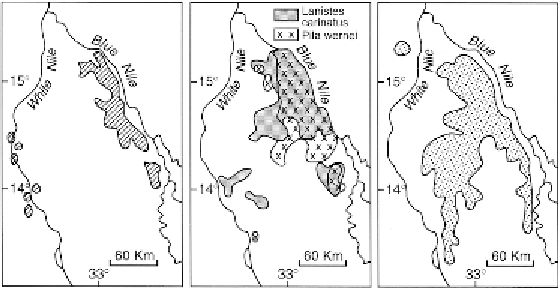Geoscience Reference
In-Depth Information
Figure 16.5. Distribution of aquatic (left box) and land (right box) snail shells in
Gezira clay, lower Blue and White Nile valleys, central Sudan. (After Williams et al.,
1982
, fig. 9.7.)
less arid than it is today, allowing the land snail
Limicolaria flammata
to colonise the
area.
Limicolaria
is a denizen of the Acacia-Tall Grass savanna, and it is found today
south of the 500 mm isohyet in central Sudan. After about 5 ka, the climate became
increasingly arid and
Limicolaria
abandoned the Gezira and colonised further south.
More complex analysis involving determining the stable carbon and oxygen iso-
topic compositions of both aquatic and terrestrial mollusca has enabled more detailed
reconstruction of former desert environments. Abell and his colleagues used changes
in the
12
C/
13
C ratio (expressed as
18
O) to
determine former temperature and salinity fluctuations in Holocene lakes and springs
in the Afar, the Nile Valley and the central Sahara (Abell,
1985
; Williams et al.,
1987
;
Abell and Williams,
1989
; Abell et al.,
1996
; Abell and Hoelzmann,
2000
; Rodrigues
et al.,
2000
). In addition, Abell and Hoelzmann (
2000
) and Rodrigues et al. (
2000
)
used changes in the stable oxygen isotopic composition in Nile oyster and Nile gast-
ropod shells to infer changes in rainfall seasonality in north-west Sudan during the
early Holocene. In the case of a series of small pans west of the lower White Nile
with abundant fossil mollusca in the upper 50 cm of sediment, Ayliffe et al. (
1996
)
were able to show that the source of the precipitation which fell when the pans were
full of water some 8,000 years ago was most likely from the South Atlantic and that
the pans were fed by local run-off and not by groundwater.
13
C) and the
16
O/
18
O ratio (expressed as
16.5 Plant macrofossils
Plant macrofossils include whole trees, leaves, fruit and charcoal. Care is needed to
distinguish between life and death assemblages, because the smaller elements like
leaves and fruit can be carried considerable distances by running water, and they
may therefore be more indicative of the plants that once grew upstream. Many leaves

